#bureau of public affairs
Text

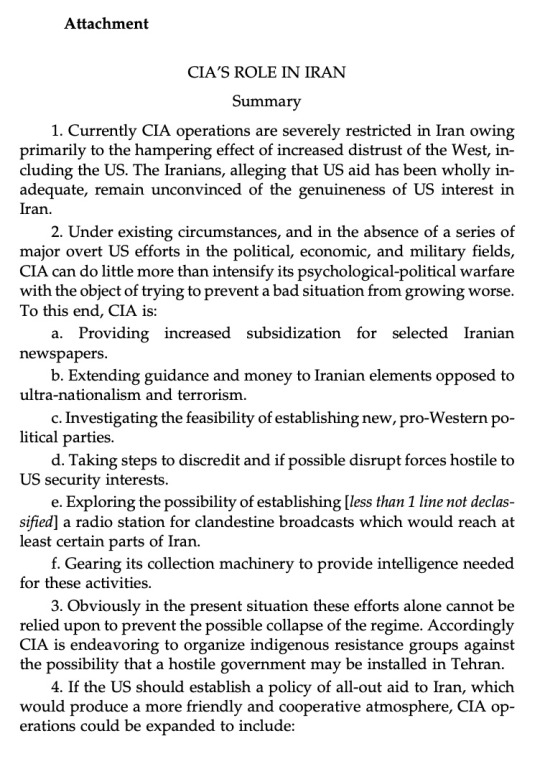
Van Hook, J. C., & Howard, A. M. (Eds.). (2017). Foreign Relations of the United States, 1952-1954, Iran, 1951–1954.United States Government Publishing Office. Full text via US State Department Office of the Historian
This is one of many volumes in the Foreign Relations of the United States series, the official documentary historical record of major foreign policy decisions and significant diplomatic activity of the United States Government. These histories incorporate an incredible number of US Department of State, CIA, and Department of Defense documents, arranged in chronological and thematic order, which improves their longevity and accessibility. This particular volume addresses US Foreign Relations with Iran from 1951-1954, during the presidential administrations of both Harry Truman and Dwight Eisenhower. These documents illustrate attitudes of US diplomats, politicians, and government employees towards Iran in the Cold War environment and, ultimately, their reasoning for instigating and backing a coup of Iranian Prime Minister, Mohammad Mosaddegh (also spelled as Mosadeq) in 1953.
The following, deeply ironic, quote comes from a memorandum from the Officer in Charge of Iranian Affairs, Office of Greek, Turkish, and Iranian Affairs (Stutesman) to the Director of the Office of Greek, Turkish, and Iranian Affairs, Bureau of Near Eastern, South Asian, and African Affairs (Richards) addressing what measures the US Government might take in support of a successor government to Mosadeq:
“It would be literally fatal to any non-communist successor to Mosadeq if the Iranian public gained an impression that the new premier was a “foreign tool”. The U.S. Government should confine any comment upon a change in government in Iran to a repetition of our traditional unwillingness to interfere in the internal affairs of a free country and our willingness to work with the government in power.”
#govpubs#1950s#1951-1954#2010s#2017#us department of state#historian of the US department of state#office of the historian#bureau of public affairs#James C. Van Hook#Adam M. Howard#Stephen P. Randolph#central intelligence agency#CIA#mohammad mosaddegh#coup#coup d'etat#overthrow#iran#operation tpajax#foreign policy#foreign relations of the united states#united kingdom#president harry s. truman#president dwight d. eisenhower#oil#cold war#ussr#communism
0 notes
Text

The Legion awaits at the gates of hell, and the NCR is gonna send'em in! [made by Zachary Fittzgerald]
#fallout#fallout show#fallout tv series#fallout amazon#fallout new vegas#fallout 4#fallout 3#fallout prime#NCR#new california republic#mojave#Mojave Bureau of Public Affairs of the New California Republic#Mojave Bureau of Public Affairs#New California Republic
171 notes
·
View notes
Video
#FCPD#fairfax county police department#Fallen Officers Memorial Service#FCPD Fallen Heroes#USA#America#Police Photography#FCPD Public Affairs Bureau#FCPD Digital; Media Team#United States of America#Northern Virginia#Commonwealth of Virginia#Virginia#Peacemakers#National Police Week#Fairfax Virginia#Fairfax County Police#Cops#Law Enforcement#Public Servants#FCPD Flickr#Police#flickr
4 notes
·
View notes
Text
What Joe Biden has Done for LGBTQ+ People
I wanted to list out everything The Biden Administration has done for Queer people in the last 3 and a half years, but according to GLAAD it'd been 337 moves (and I noticed they missed a few things...) there was just no way to list every ground breaking first Queer person ever nominated to fill this or that job, every ally with a historic LGBT rights record nominated for a top job, every beautiful statement of support, every time he tried to get Congress to pass the Equality Act (support it!) So I've gone through and done my best to pick the ones I think were the most important, but everyone should check out the full list!
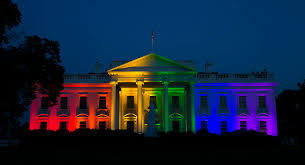
Day 1: Signs executive orders banning discrimination and ordering a full review of all federal agencies policies to better include and support LGBT people
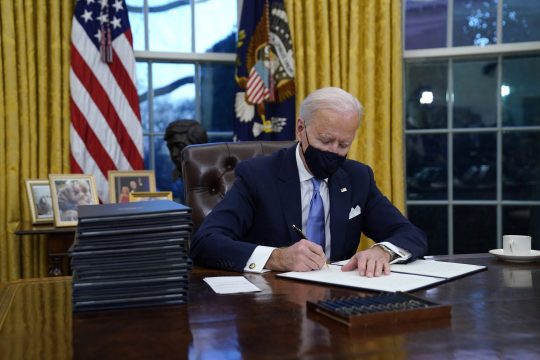
Pete Buttigieg becomes the first openly gay person nominated and confirmed for a cabinet level post as Secretary of Transportation
Revokes Trump’s 2018 ban on transgender military personnel
Department of Housing and Urban Development implements LGBTQ protections in housing, becoming first federal agency to implement Pres. Biden’s executive order
First President to recognize and proclaim Trans Day of Visibility
Department of Justice Civil Rights Division issues an official memo that the Supreme Court's Bostock decision against LGBT workplace discrimination also applies to education through Title IX
HUD withdraws a Trump Administration proposed rule change, and reaffirms trans people's rights to seek shelters matching their gender identity
HHS announces the withdrawal of Trump Administration rules that allowed discrimination by healthcare organizations against LGBT people.
The State Department and later Homeland Security announce babies born to Queer couples overseas will be American citizens if one parent is American, in the past the child only qualified if they were genetically related to the American citizen parent.
The Justice Department files against a West Virginia law banning trans students from school athletics
Department of Veterans Affairs announces it will offer gender confirming surgery for transgender veterans. There are an estimated 134,000 transgender veterans in the U.S. and another 15,000 transgender people serving in the armed forces.
President Biden Signs a law making the Pulse Night Club a national memorial
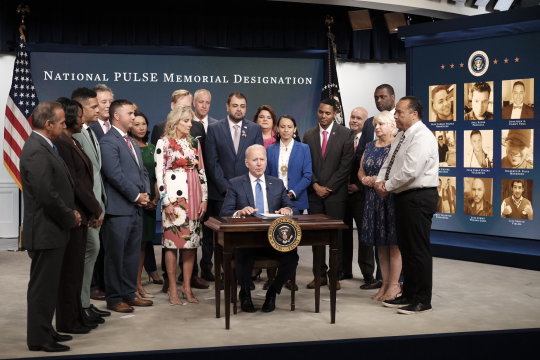
The State Department creates an X gender marker for passports and other documents, allowing gender affirming identification for non-binary and intersex people for the first time.
The Census Bureau for the first time issues a Survey with questions about sexual orientation and gender identity
On the 10th anniversary of the repeal of Don’t Ask Don’t Tell, Veterans Administration announces that soldiers discharged for homosexual conduct, gender identity or HIV status qualify for veterans' benefits
Dr. Rachel Levine becomes the first trans person confirmed by the US Senate when she was nominated to be Assistant Secretary for Health, she also became the first trans flag rank officer when she was sworn in as a 4 star Admiral for her job as head of the Public Health Service Commissioned Corps, his makes her the highest ranked trans person in government

Holds the first ever vigil in the White House for Transgender Day of Remembrance
HHS announces rule change to reinstate and expand protections against discrimination in the Affordable Care Act, including denying coverage for gender-affirming care.
Social Security Administration reverses a Trump Administration policy and allows benefits claims by surviving partners in same-sex relationships, whose partner died before marriage equality was legal
President Biden signs the reauthorization of the Violence Against Women Act (a bill he helped originally craft in the Senate) which for the first time has grant programs dedicated to expanding and developing initiatives specifically for LGBTQ survivors of domestic violence
The TSA announces new technology and policy shifts to improve the customer experience of transgender travelers who have previously been required to undergo additional screening due to alarms in sensitive areas.
The Social Security Administration allows people to edit their gender and name on records for the first time without legal and medical documentation
The US Air Force announces it'll offer medical and legal aid to any personnel families affected by state level anti-trans youth bills.
Karine Jean-Pierre becomes the first Lesbian to serve as White House Press Secretary

on 50th anniversary of Title IX The Department of Ed strengthens protections for Students against sexual harassment and discrimination
Veterans Affairs announces survivor benefits now extended to partners from relationships before marriage equality was legalized in 2015
President Biden signs the Respect for Marriage Act into law enshrining protections for marriage equality for same-sex and interracial couples
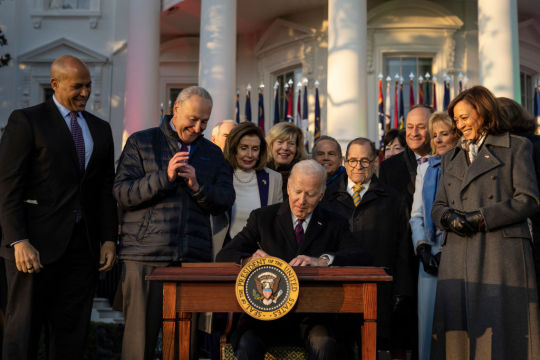
The Department of Ed announces new rules around athletic eligibility under Title IX, declaring blanket bans on trans students violate the law and setting up strike standards for schools
The White House announced a suit of new protections for LGBTQ people, including a new job at the Department of Ed to combat book bans, a joint DoJ Homeland Security effort to combat violence and threats and HHS evidence-based guidance to mental health providers for care of transgender kids
President Biden signs an Executive Order directing HHS to protect LGBTQI+ youth in the foster care system, a rule they later passed requiring Queer foster children to be placed in affirming homes
The Biden administration joins families of transgender youth in Tennessee and Kentucky in petitioning the U.S. Supreme Court to review and reverse a circuit court ruling allowing a ban on mainstream health care to be enforced
President Biden Signs a EO expanding on past EO on equality and helping underserved communities
The Department of Education's Civil Rights office opens an investigation into the death of Nex Benedict. President Biden in his statement said: "Every young person deserves to have the fundamental right and freedom to be who they are, and feel safe and supported at school and in their communities. Nex Benedict, a kid who just wanted to be accepted, should still be here with us today. Nonbinary and transgender people are some of the bravest Americans I know. But nobody should have to be brave just to be themselves. In memory of Nex, we must all recommit to our work to end discrimination and address the suicide crisis impacting too many nonbinary and transgender children.”
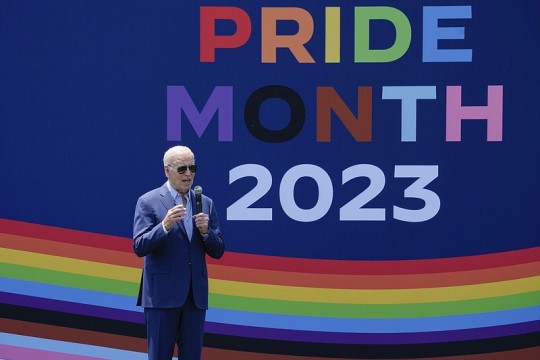
#Joe Biden#Thanks Biden#pride#pride month#politics#US politics#LGBT#LGBTQ#Queer#Trans#gay#civil rights#there's a lot more
2K notes
·
View notes
Text
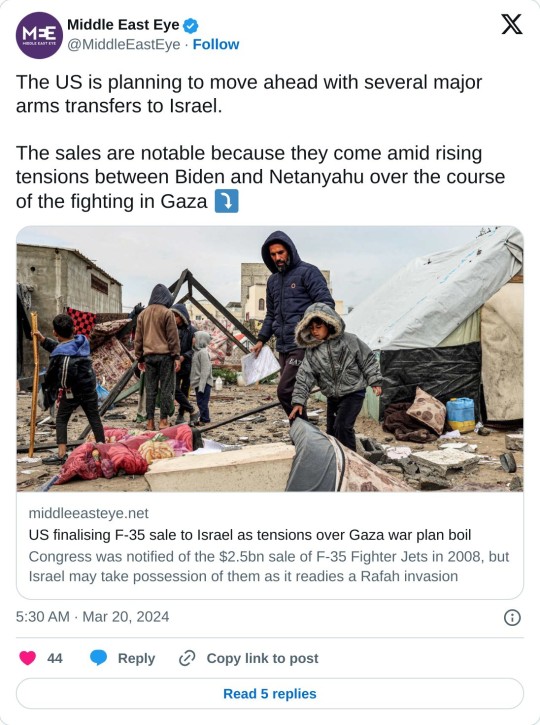
Part of the package of arms transfers that the US will notify to Congress is a new shipment of precision-guided munitions worth more than $1bn dollars and a $2.5bn sale of F-35 fighter jets, Josh Paul, the former director of congressional and public affairs for the State Department’s bureau of political-military affairs, said.
The sales are notable because they come amid rising tensions between Biden and Netanyahu over the course of the fighting in Gaza.
On Monday, US national security advisor Jake Sullivan said that Biden warned his Israeli counterpart it would be a “mistake” to launch a full-scale ground invasion of Rafah, the southern Gaza city where 1.5 million Palestinians are sheltering.
Israel is set to send a technical team to the US to discuss its invasion plans as early as this week, Sullivan said. But on Tuesday, Netanyahu reaffirmed his intention to launch a “ground incursion” into Rafah.
#yemen#jerusalem#tel aviv#current events#palestine#free palestine#gaza#free gaza#news on gaza#palestine news#news update#war news#war on gaza#rafah under attack#rafah#all eyes on rafah#genocide joe#joe biden#genocide#gaza genocide
216 notes
·
View notes
Text
Another story idea given by @maturedadsandmen
BIRD IN THE HAND
Cole Walker was about two blocks from his destination when his phone rang. He normally wouldn't answer it, but it was his sorta-kinda boyfriend/fuckbuddy John. Cole still made fun of John for still preferring to call instead of just text, but that's what you get sometimes for dating a man much older.
"Hey," the 24 year old answered. DC weather had moved from cold to brisk and his cheeks were flush.
"Hiya sexy," the said. John's voice was a craggy tenor, with an upstate New York accent. "Just wanted to hear your voice."
Cole smiled. The whole arrangement with John was weird, to say the least. The congressional staffer didn't even know the guy's last name. John was an FBI agent who was VERY closeted. In a town like DC, that wasn't unusual, and Cole himself had only told a couple of close friends that he was gay. But John seemed to want the boyfriend stuff as much as the sex. Cuddling, long talks, dates. All while being crazy protective of his privacy.
"Tough day?" Cole asked. He wished he didn't feel so eager to talk to the man, but it wasn't like he was ready for an open boyfriend either. The fact the federal agent was 47 made something real and public seem impossible to the younger man. He, too, enjoyed the play-pretend nature of their dating if he was honest with himself.
"And how," John breathed. "I'm about to meet a buddy for dinner, but I wanted to call... we still on for date night Saturday? I'll take you somewhere nice." It was only then that Cole could tell the man was in a public place and talking a little quieter than normal.
"Yeah," Cole replied. "And you don't have to go all out. I just enjoy seeing you."
There was a contrite pause on the other end. "I know I've not been good at things lately.. but would it be pushing my luck to have you stay over this time?"
Cole's heart pounded. It was hard to hold a grudge. "No, not at all."
John's volume got lower. "Damn, studly," he hissed. "That's gonna help me get through this week all right."
"Yeah," the younger man chimed in.
"Listen... I gotta go. But see you Saturday?"
"Yep," Cole replied. "Looking forward to it."
After they hung up, Cole felt guilty. It wasn't like he and John were boyfriends, really, not in the conventional sense, and they'd never said anything about being exclusive. If the agent ever asked, Cole would very likely agree to be a one-man guy but until then...
But the real reason he felt guilty is that Paul Ricciardi pushed his buttons in a different way than John. Cole dubbed him the "Head Honcho" is his mind, and while Ricciardi wasn't the number one guy at the Bureau, he wasn't that far down the org chart. In a lot of ways, he was the opposite of John - married and addicted to down-low sex, more dominant in bed, and confident in hooking up with a recently graduated dude despite his high-profile position. He knew Cole Walker was after dick and wasn't gonna blab to anyone.
Paul was just wrapping up a phone call when he heard the buzzer of the apartment. The rental was justified as a place to crash for late nights, but certainly his wife knew her 53-year-old husband kept on an affair, maybe more than one. They just never talked about it. The dont-ask-dont-tell approach worked for the law man.
Ricciardi's gruff face cracked a smile when he opened the door to see Cole. Dudes like this were dime a dozen in DC... congressional staffer, needy bottom, daddy issues galore. But this Walker kid was exceptional: he'd played soccer at Georgetown and his bulking up since graduation had interfered with that youthful jock look. The real deal. No two ways about, Cole was gorgeous. Just the right amount of masculine, the right amount of cute, total boy-next-door who still carried that jock gain as he walked in.
"Hey," Cole's voice said, quietly as he walked in. He respected Paul's need for discretion, it was almost intuitive.
"Hey," the career law enforcement man whispered in a soft growl, shutting the door. "You look hot as fuck."
Cole's eyes swept up Ricciardi's build. Mid-50s and fit as ever, the toned daddy beef filling out Paul's conservative but expensive suit and the short-cropped gray hair setting off the intensity of the man's brown eyes. The tie was loosened but other wise he was a poster boy for Bureau leadership. "You too," he gulped.
Paul grinned and reached up to cup the back of Cole's neck, yanking the younger man into a hot kiss.
Cole moaned into Paul's mouth as that thick tongue conquered him. He could taste scotch and smell the man's cologne. Reflexes kicked in as he reached forward to hold the man's suited waist, enjoying the feel of the Head Honcho's hard body beneath.
The kiss was over as quickly as it started. Ricciardi stepped back and reached down to unzip his suit trousers. The man wasn't overly hung - like John, his cock was meaty, even fat. "Gonna suck Daddy's cock, kid?" Paul roughly growled.
"Fuck yes," Cole said. He's been with only six men since first becoming sexually active at 21. But he quickly realized he was all bottom - orally and anally. He was still surprised he'd bagged two FBI men over the last year and a half. Luck, for sure, but it was also clear the ex-soccer jock had a type. Both Paul and John were strong, silent daddy personalities. His own father was a PA state trooper, and one day Cole would have to analyze the fucked-up part of his head that got turned on by that. Or not. Maybe it was something that could never fully be explained - it's just something about a law enforcement man pushed his buttons big time.
Paul Ricciardi was careful about who he fucked. He had a one-at-a-time rule, for the sake of discretion. By now, he'd had his share of hot young men. He'd met some real sluts and a couple of ex-jocks like Cole. But no one had combined that effortless masculinity with a real bottom eagerness like this kid.
"Fuck yeah," he growled as Cole began deep throating that fat hog. "Swallow Daddy."
More than he realized Cole was worked up that evening. He would have chalked it up to missing this cock, but actually Paul had reached out to him more frequently lately, no longer the once a month booty call. Maybe the more he had it, the more he wanted it.
That hand now clasped the back of Cole's neck and held tight as Paul's hips went into overdrive. Fast hard jabs battered the back of Cole's gullet. It was too much, and Cole coughed some on it, which made Paul pause before starting a gentler, if no less deep, thrusting.
Finally he pulled out, that dick spit wet and rock hard. It was beautiful to Cole. Like with John, he decided he liked the extra girth more than he craved extra length. For as bottomy as he was, the young stud wasn't a size queen. He'd prefer a tool that could use him without too much discomfort.
"To the bedroom, kid," Paul hissed, a hint of a smile cracking on the stern face. He was used to being in charge in every aspect of his life. He was in charge now. But something about this jock stud made him feel a little less in control.
Cole scrambled up. He'd learned to come over to Paul's prepared. Sometimes the two took their time, sometimes the married man seeded him in two minutes flat and sent him back home. As they entered the spare bedroom for the apartment, Cole quickly peeled off his sweatshirt and T in one move and just as quickly kicked off his sneakers and peeled down the jeans. There was nothing underneath and his own hardon stood up erect and excited. Cole may not have had the girth of his boyfriend or this man, but he was hung longer and the sparser crotch hair made his jock bone look even longer.
Paul was taking off his suit and laying it on a chair. He'd hang it up later. For now, his ravenous eyes were on Cole as he got onto the bed, on all fours. They didn't always mate this way but it was Ricciardi's favorite position, and Cole's too, thought they'd never talked about it. They just fucked.
Then watched the Head Honcho step toward the bed, his body tightly dense from dedicated workouts. The chest fur wasn't as silver as his hair, but it was getting there, and it got denser the closer toward that magic cock, which was already dripping.
"Damn, when was the last time you got off?" Cole asked.
Paul climbed on the bed and ran his hand over the ex-jock's dusty haired but half smooth rump. "Fucked the wife yesterday," he hissed. "I'm just a horny guy."
"I'll say," Cole replied. He didn't know what he thought about fooling around with a married man. It probably wasn't the moral thing to do. At least John was single, or said he was single. Maybe the man lied, hence the lack of a last name.
Then Cole felt the nuzzling of the man's face in his clean crack and the contact of that thick tongue. John was actually better at rimming, or at least liked to go longer, but something about Paul's intensity drove him wild. "Yes," he hissed backing his ass back against the man's munching face. A hard slap hit his cheek as the Head Honcho dove in more eagerly. It was gonna be a quick one, but Ricciardi was a grade-A ass man and could rarely resist a taste of Cole's jock hole.
"Goddamn," the FBI man finally said as he leaned up. Cole could feel that hard beef press against his back as Paul reached over for some lube. Just a squirt, not too much... Ricciardi liked a snug ride.
The man quickly fingere Cole and almost as quickly lined up that fat prick to press in.
Cole's deflowering, the night after his 21st birthday, had been by a very patient man, and he'd lucked out to find a couple of tops who knew how to go slow at first. Paul Ricciardi was the first man to show Cole he didn't always need slow.
That dick popped in now, snapping open the elasticity of the young man's pucker.
"Fuck yes!" Paul growled. He leaned forward again, covering Cole's smooth back with his own meaty furry one. "You feel that kid?"
"God yes," Cole hissed. Maybe it was the rank or the badge, but everything about Paul turned him on and made this FAR easier than he'd ever imagine. He even enjoyed the crude way Ricciardi's bone just barreled in further, past his internal tightness. "Fuck me, man."
That was Paul's cue, his green light. Wrapping an arm around Cole's shoulder and neck, he held on tightly and thrust all the way into the hot stud. Barely taking a rest, he began fucking, hard.
"Oh fuck!" Cole whimpered. He wished he could keep his normally deep voice low, but the pitch rose once Paul reamed him like this. "Oh god, oh fuck!"
A hand clasped over his mouth. Paul wasn't overly verbal today, though he could be. Instead he gripped the kid close and rode him hard. It had been a tough week and he needed a fuck like this to channel his stress.
Each mating like this made Cole wonder if it could get better. His prick was now leaking like crazy on Paul's bedsheets and his muscles flexed involuntarily in the man's strong grip.
THIS is what made him feel about going around behind John's back. Cole wished to god that John could fuck like this, or would fuck like this. The Head Honcho was even less available a man than John, but he outmanned Cole's boyfriend in the sack.
BAM, BAM, BAM. Paul's fat cock was relentless now. Some guys couldn't take it. Cole could, and would. The very knowledge had the FBI big-wig's prick getting slick with his own precum.
Cole concentrated and forced himself to quiet his moans. The hand unclasped from his mouth and moved to feel up more of the ex-soccer jock's lean body.
"You're close," he heard. Paul wasn't asking a question.
Cole forced his voice back to its deeper register. "Yah." He felt light headed now. Before Paul he thought hands-free cums were a myth. They weren't though, and he was about to offer proof again now.
"Oh shit," he breathed in a whisper. His dick jerked and the first spray of precum jetted out, matching what Paul was pushing deeper and deep into his guts with each hard jab.
BAM, BAM, BAM. The fucking was harder and faster, if possible, only Ricciardi was starting to lose his cadence. The man was orgasming now.
Cole's dick now jerked again, and the cum flew out. Seven heavy ropes of young cum being pressed out from within. Cole didn't pass out exactly, but he lost focus, like he'd sucked too many poppers at once.
Paul's body slowed and now rested immobile on his back. A light kiss was the one gesture of affection Ricciardi offered him, ever, but the simple act was more powerful for it. Cole wished he could have experienced his partner's cum more vividly, but the payoff of the simultaneous orgasm made up for it. He and John had done that once.
Paul rolled his muscular, FBI-fit body off his sexual conquest and lazily plopped onto the mattress. He was sweaty and handsome as fuck and his prick still twitched in its wetness, semen oozing out of the tip.
Just as lazily Ricciardi reached over to stroke Cole's side as the younger stud gingerly stretched his legs and lay on his back. "Remind me to thank your boyfriend for the hall pass," he hissed.
Cole had told the Head Honcho that he was seeing someone. He's admitted it to put Paul at ease for a discreet hookup, but he regretted sharing that info now. "He doesn't know, actually."
Paul chuckled. "I thought you said you had an arrangement... but that's cool, kid."
Cole felt embarrassed. "I mean, we don't have an exclusive thing, but I guess I haven't gone into details with him."
Normally the Head Honcho would be getting up, going to piss, showering off, or just slipping on some sweat pants in a clear signal it was Cole's time to go. Instead the man's eyes seemed not to get enough of the 24-year old and his hand moved up to gingerly stroke Cole's cute-handsome face.
"Well, I'm glad this works out for you," Ricciardi said. "I know I come on strong, but you're really fucking hot."
"I know," Cole smiled. He knew his worth, but it was also a joke.
Paul got it, chuckling. "As you can tell, I'm a busy man... but I'd love to see you a little more often. If it works out with you and your boyfriend." For a take-charge man, he seemed surprisingly shy in his request.
"That's be hot," Cole said. Paul Ricciardi didn't kiss as much as Cole would like, almost never after the act itself. But it was hard to give up the man's harder approach in bed and his overall sexiness. "You're really fucking hot, too."
"I know," Paul repeated Cole's joke back to him in perfect timing. "Am I hotter than your boyfriend?" he asked with a wink, then patted Cole's chest. "Sorry, that was my male competitiveness kicking in."
Cole nodded. He wasn't going to give Paul the satisfaction of an answer. Besides he didn't know how he would answer. John was sexy as fuck, too, and reminded Cole a lot of Paul in his stature, build, and appearance. "Maybe I shouldn't admit this but he works for the bureau, too."
"Yeah?" he smirked.
"Yeah," Cole nodded. He was glad to see Paul's laid back side. Maybe being married, the man wasn't bothered by hearing about another man. Lazily, the man's fingers caressed Cole's chest muscle. "John. A field agent," Cole said, opening up. He'd not been able to tell a single other soul about the most important development of his life over the last year. It turns out this DL hookup with a DC big shot gave him the only opportunity. He blushed as he added, "Funny thing is I don't even know his last name. He's super closeted. Always going on about how he's married to the Bureau and doesn't have time for anything else."
"Sounds like my brother Jo..." Paul stopped, his face growing beet red and his fingers pausing in their motion on Cole's naked body. "Jesus Christ, you're not fucking my brother are you?"
Cole was taken aback. The idea was crazy and yet once Paul said, he knew it was possible, even likely. The resemblance wasn't dead-on, but it wasn't far apart either. "I dunno," he stammered. "Fuck."
Paul got out of bed and Cole felt bad. Ashamed but also pissed. This guy was probably overreacting. There had to be a thousand Johns in the Bureau. But judging from the Head Honcho's reaction, Cole worried he'd fucked up a good thing.
Only Paul's expression wasn't anger as he walked back in. He had his phone in his hand. He slid back into bed and held it up. There was a photo of John already, probably taken a year ago at the beach, the agent in chino shorts and a casual polo, barefoot in the sand at sunset.
"Is that him?" Paul asked, like he was interrogating a suspect.
Cole nodded, tears welling at the edge of his eyes. "Sorry, Paul," he muttered. "Fuck, I didn't know."
Paul gave a grimace which was strangely comforting as he set down his phone. "I know you didn't, kiddo." He gave Cole a good look, like he was still trying to process things. "Confirmed bachelor, my ass," he laughed cynically.
"I don't know... he's kept things casual with us. Sometimes I think it's more a fuck buddy thing, you know?" Cole was trying to make it sound better, but the more he talked the more he realized it was sounding worse.
Paul had one last shake of the head. "Well, my brother had good fucking taste... I'll give him that." Then, "maybe you should go, OK?"
His tone was surprisingly empathetic, not mean. Cole could tell Paul was feeling concern that he'd encroached in onto his brother's guy and was processing the fact John was very probably full-on gay. And maybe the Head Honcho was worried how Cole was processing all this.
"Yeah," the ex-jock said, quickly gathering his clothes to put back on.
"Don't worry, kid," Paul said, leaning up in his bed, still naked and hunky looking. "This shit happens. Well, maybe not very often, but it's nothing to get freaked over."
"I'm OK," Cole said gamely. A million thoughts were racing in his mind but one worry in particular.
"But what?" Ricciairdi prompted, able to tell something was bugging the young guy.
"I shouldn't admit this," Cole said. "But I'm gonna miss the sex we've had."
Paul's brown eyes sought his and it was like their connection was a spark of energy. "Me, too, kid, me too."
Cole Walker thought about those words the whole walk back to his apartment.
186 notes
·
View notes
Text
Updated version! ID written by @swosheep (it won't let me tag you oof)

ID 1: All images are of an Instagram post by letstalkpalestine2. The first one is titled "Lets Talk. What is Hamas? Answering the basic questions".

ID 2: the second image is titled "What Are Its Origins?". the body text reads: "Hamas is a Palestinian political party and armed resistance movement based in the besieged Gaza Strip. It emerged in 1987, at the start of the First Intifada, as a reaction to intensifying israeli violence and as a religious alternative to the secular Palestinian parties that dominated the scene at the time. Hamas was originally a branch of Egypt's Muslim Brotherhood but later cut ties with it and became an independent group. In 1992, Hamas formed a military wing called the Izz al-Din al-Qassam Brigades to resist the israeli occupation. The Brigades carried out several significant operations against Israel during the Second Intifada, which established Hamas as a leading force in the Palestinian resistance."

ID 3: the third image is titled "Who Are Its Leaders?". The body text reads: "Hamas is composed of a political wing and a military wing. They each perform different functions but operate under the same leadership structure." There is a grid with four sections. The first section is titled "Political Bureau", and reads: "- Headed by Ismail Haniyeh from exile - Sets general policy". The second section is titled: "Izz al-Din al-Qassam Brigades" and reads: "- Commanded by Marwan Issa and Mohammed Deif - Conducts military operations". The third section is titled: "Shura Council" and reads: "- Led by Saleh al-Arouri in the West Bank and Yahya Sinwar in Gaza - Handles affairs in Gaza, the West Bank, diaspora, and israeli prisons". The fourth section is titled: "Gaza Government" and reads: "- Headed by Prime Minister Issam al-Da'alis - Enacts policies and provides social services to people in Gaza".

ID 4: The fourth image is titled: "What Does Hamas Want?" The body text reads: "Its 2017 charter states that its current political program is to: - Implement the right of return for all Palestinian refugees; - Establish a temporary Palestinian state along the 1967 borders (the West Bank, including East Jerusalem, and the Gaza Strip) and arrange a long-term truce with israel. Hamas considers the establishment of a Palestinian state on the '67 borders as a temporary step. It refuses to recognize israel's legitimacy and advocates for the 'full and complete liberation of Palestine, from the river to the sea.' Hamas's 2017 charter states that its struggle is against the israeli state and the Zionist movement due to their occupation of Palestine, not Jewish people, and criticizes israel for associating its actions with Jewish values. Hamas's stated goals for its current operation are to - Free the thousands of Palestinian prisoners held by israel, - End the Gaza blockade, - End the status quo where Israel continues its occupation without cost".

ID 5: the fifth image is titled: "Does Hamas Control Gaza?". The body text reads: "Not really. Hamas administers local affairs, while israel controls much of Gaza from the outside through its blockade. israel forcibly controls: - Airspace, - Sea access, - Movement of all goods and people in and out, - Telecoms networks, - Electromagnetic sphere, - Tax distribution, - Population registry, - Water, - Electricity and fuel. Hamas began governing Gaza in 2007, and has since managed: - Healthcare, - Education, - Infrastructure, - Social welfare, - Law enforcement, - Public employment. Hamas is not a sovereign government. israel's blockade prevents Palestinians from independently exercising sovereignty over Gaza's population, development, and economy."
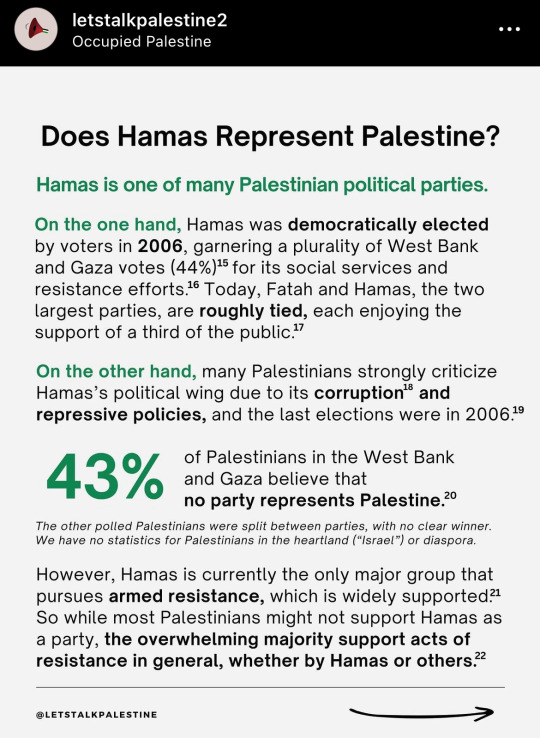
ID 6: The sixth image is titled "Does Hamas Represent Palestine?" The body text reads: "Hamas is one of many Palestinian political parties. On the one hand, Hamas was democratically elected by voters in 2006, garnering a plurality of West Bank and Gaza votes (44%) for its social services and resistance efforts. Today. Fatah and Hamas, the two largest parties, are roughly tied, each enjoying the support of a third of the public. On the other hand, many Palestinians strongly criticize Hamas's political wing due to its corruption and repressive policies, and the last elections were in 2006. 43% of Palestinians in the West Bank and Gaza believe that no party represents Palestine. The other polled Palestinians were split between parties, with no clear winner. We have no statistics for Palestinians in the heartland ("israel") or diaspora. However, Hamas is currently the only major group that pursues armed resistance, which is widely supported. So while most Palestinians might not support Hamas as a party, the overwhelming majority support acts of resistance in general, whether by Hamas or others."

ID 7: the seventh image is titled "Is Hamas a Proxy of Iran?". The body text reads: "No. Hamas is an independent group with a political program and military strategy distinct from Iran. Hamas and Iran are strategic allies, meaning that while Iran provides Hamas with significant financial, military, and political support, Hamas does not act or operate on behalf of Iran. It makes decisions based on its own interests, and independently manages relations with countries like Turkey, Qatar, and Egypt. For example: In 2012, Hamas cut ties with Syria because it opposed the Assad regime's violent crackdown on protesters. It took this decision despite angering Iran, a close ally of Assad. Regarding Operation Al-Aqsa Flood, even israeli officials admit there is no evidence that Iran was in any way involved. Iran was actually surprised by it. Hamas independently coordinated and launched the operation to achieve its own goals."

ID 8: The eighth image is titled "Does Hamas Negotiate with Israel?". The body text reads: "Hamas views armed struggle as only one of several tools to end apartheid & occupation, such as diplomacy. In 2006, in an op-ed for The Guardian, Hamas chairman Ismail Haniyeh revealed that israel refused Hamas's proposal for a truce. In 2008, former Hamas chief Khaled Meshal offered a 10-year truce in exchange for a sovereign Palestinian state along the 1967 borders with Jerusalem as its capital." israel rejected the proposal. In 2016, Hamas offered a long-term truce in exchange for simply ending the Gaza Blockade. israel rejected it. In 2018, Haniyeh revived this offer by sending a handwritten letter in Hebrew to Israeli Prime Minister Netanyahu. But israel rejected it again. israel repeatedly rejected Hamas's diplomatic initiatives because israel saw no reason to end the oppressive status quo, which it believed gave it power & privileges over Palestinians with minimal downsides. israel's benefits outweighed the costs. Hamas is trying to change that."

ID 9: the ninth image is titled "Is Hamas Risking Palestinian Lives?". The body text reads: "Westerners often accuse Hamas of risking Palestinian lives by fighting apartheid and thus inviting a deadly israeli crackdown. But the reality is that israel's blockade is slowly killing everyone in Gaza. [quote] 'We have paid a high cost in lives in this conflict. But if that's the price for long-term changes - breaking the siege and obtaining freedom - it's one many of us feel we have no choice but to swallow.' [unquote] -Haytham Besalso, civil engineer from Gaza, 2014. [quote] 'We are bleeding here, anyway [..] The Gaza Blockade crushes any opportunity for peace.' [unquote] -Ismail, anonymous journalist from Gaza, 2021. The argument that Hamas is responsible for israel's killing of Palestinians is malicious. It blames the victims for resisting apartheid and absolves the oppressors of responsibility, treating the mass killing of children as a 'normal' israeli response."

ID 10: the tenth image says: "You don't need to support Hamas as a political party to support Palestine. Most Palestinians don't support it as a party. But Hamas is an effective political player in the struggle against apartheid, oppression, and colonization. It has achieved remarkable success in preventing israeli violence in Jerusalem and freeing Palestinian hostages abducted by israel. Hamas has institutions, ministries, student movements, and women's movements, and employs thousands of doctors, teachers, judges, and aid workers. It is part of the fabric of Palestinian society. So while you don't need to support Hamas to support Palestine, you cannot oppose oppression without supporting the resistance to it. You cannot support freedom while supporting israeli efforts to wipe out those who fight for that freedom, including Hamas, to leave Palestinians defenc Pales".
End ID.
the original caption states that @/LetsTalkPalestine2 does not endorse any specific party, including Hamas, and that the last word on the last slide should be *defenseless.
#resources#reaux speaks#bipoc#free palestine#palestine#free gaza#gaza#west bank#genocide#ethnic cleansing#israel#ceasefire#hamas#instagram
190 notes
·
View notes
Text
Poor people pay higher time tax
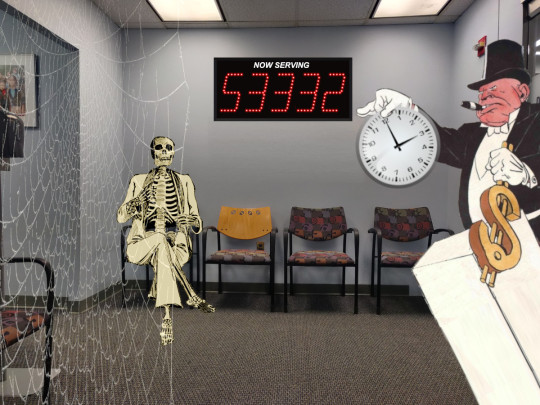
Doubtless you’ve heard that “we all get the same 24 hours in the day.” Of course it’s not true: rich people and poor people experience very different demands on their time. The richer you are, the more your time is your own — not only are many systems arranged with your convenience in mind, but you also command the social power to do something about systems that abuse your time.
If you’d like an essay-formatted version of this post to read or share, here’s a link to it on pluralistic.net, my surveillance-free, ad-free, tracker-free blog:
https://pluralistic.net/2023/02/10/my-time/#like-water-down-the-drain
For example: if you live in most American cities, public transit is slow, infrequent and overcrowded. Without a car, you lose hours every day to a commute spent standing on a lurching bus. And while a private car can substantially shorted that commute, people who can afford taxis or Ubers get even more time every day.
There’s a thick anthropological literature on the ways that cash-poverty translates into #TimePoverty. In David Graeber’s must-read essay “The Utopia of Rules,” he nails the way that capitalist societies generate Soviet-style bureaucracies, especially for poor people. Means-testing for benefits means that poor people spend endless hours filling in forms, waiting on hold, and lining up to see caseworkers to prove that they are among the “deserving poor” — not “mooches” who are defrauding the system:
https://memex.craphound.com/2015/02/02/david-graebers-the-utopia-of-rules-on-technology-stupidity-and-the-secret-joys-of-bureaucracy/
The social privilege gradient is also a time gradient: if you can afford a plane ticket, you can travel quickly across the country rather than losing days to the Greyhound or a road-trip. But if you’re even richer, you can pay for TSA Precheck and cut your airport security time from an hour to minutes. Go further up the privilege gradient and you’ll acquire airline status, shaving another hour off the check-in process.
This qualitative account of time poverty is well-developed, but it’s lacked a good, detailed quantitative counterpart, and our society often discounts qualitative work as mere anecdote and insists on having every story converted to numbers before it is taken seriously.
In “Examining inequality in the time cost of waiting,” published this month in Nature Human Behavior, public affairs researchers Steve Holt (SUNY) and Katie Vinopal (Ohio State) analyze data from the American Time Use Survey (AUTS) to produce a detailed, vibrant quantitative backstop to the qualitative narrative about time poverty:
https://www.nature.com/articles/s41562-023-01524-w
(The paper is paywalled, but the authors made a mostly final preprint available)
https://osf.io/preprints/socarxiv/jbk3x/download
The AUTS “collects retrospective time diary data from a nationally representative subsample drawn from respondents to the Census Bureau’s Community Population Survey (CPS) each year.” These time-diary entries are sliced up in 15-minute chunks.
Here’s what they found: first, there are categories of basic services where high-income people avoid waiting altogether, and where low-income people experience substantial waits. A person from a low-income household “an hour more waiting for the same set of services than people from high-income household.” That’s 73 hours/year.
Some of that gap (5%) is attributable to proximity. Richer people don’t have to go as far to access the same services as poorer people. Travel itself accounts for 2% more — poorer people wait longer for buses and have otherwise worse travel options.
A larger determinant of the gap (25%) is working flexibility. Poor people work jobs where they have less freedom to take time off to receive services, so they are forced to take appointments during peak hours.
Specific categories show more stark difference. If a poor person and a wealthy person go to the doctor’s on the same day, the poor person waits 46.28m to receive care, while the wealthy person waits 28.75m. The underlying dynamic here isn’t hard to understand. Medical practices that serve rich people have more staff.
The same dynamic plays out in grocery stores: poor people wait an average of 24m waiting every time they go shopping. For rich people, it’s 15m. Poor people don’t just wait in longer lines — they also have to wait for understaffed stores to unlock the cases that basic necessities are locked behind (poor people also travel longer to get to the grocery store — and they travel by slower means).
A member of a poor household with a chronic condition that requires two clinic visits per month loses an additional five hours/year to waiting rooms when compared to a wealthy person. As the authors point out, this also translates to delayed care, missed appointments, and exacerbated health conditions. Time poverty leads to health poverty.
All of this is worse for people of color: “Low-income White and Black Americans are both more likely to wait when seeking services than their wealthier same-race peer” but “wealthier White people face an average wait time of 28 minutes while wealthier Black people face a 54 minute average wait time…wealthier Black people do not receive the same time-saving attention from service providers that wealthier non-Black people receive” (there’s a smaller gap for Latino people, and no observed gap for Asian Americans.)
The gender gap is more complicated: “Low-income women are 3 percentage points more likely than low-income men and high-income women are 6 percentage points more likely than high-income men to use common services” — it gets even worse for low-income mothers, who take on the time-burdens associated with their kids’ need to access services.
Surprisingly, men actually end up waiting longer than women to access services: “low-income men spend about 6 more minutes than low-income women waiting for service…high-income men spend about 12 more minutes waiting for services than high-income women.”
Given the important role that scheduling flexibility plays in the time gap, the authors propose that interventions like subsidized day-care and afterschool programming could help parents access services at off-peak hours. They also echo Graeber’s call for reduced paperwork burdens for receiving benefits and accessing public services.
They recommend changes to labor law to protect the right of low-waged workers to receive services during off-peak hours, in the manner of their high-earning peers (they reference research that shows that this also improves worker productivity and is thus a benefit to employers as well as workers).
Finally, they come to the obvious point: making people less cash-poor will alleviate their time-poverty. Higher minimum wages, larger earned income tax credits, investments in low-income neighborhoods and better public transit will all give poor people more time and more money with which to command better services.
This week (Feb 13–17), I’ll be in Australia, touring my book Chokepoint Capitalism with my co-author, Rebecca Giblin. We’re doing a remote event for NZ on Feb 13. Next are Melbourne (Feb 14), Sydney (Feb 15) and Canberra (Feb 16/17). More tickets just released for Sydney!
[Image ID: A waiting room, draped with cobwebs. A skeleton sits in one of the chairs. A digital display board reads 'Now serving 53332.' An ogrish, top-hatted figure standing at a podium, yanking a dollar-sign shaped lever looms into the frame from the right. He holds a clock aloft disdainfully, pinched between the thumb and fingers of one white-gloved hand.]
#pluralistic#scholarship#auts#american time use survey#time use#jenny odell#race#graeber#david graeber#how to do nothing#utopia of rules#inequality#gender#time poverty
802 notes
·
View notes
Text
I was just in the comments section of an article on the as-yet-unexplained death of the actor Cole Brings Plenty and hoo boy if you want to be extremely fucking antique cartoony racist in mixed public company with no word filters or peer disapproval to slow you down in 2024, being racist against indigenous Americans is still the smart money. we love being insanely racist across the board over here in the good ol US of A but in a large portion of the country's infrastructure there has been at least the superficial appearance of disapproval and word bans online for most race based hate rhetoric, even if very little of it is sincerely enforced. not for indigenous hate. the shit I have seen even self-identified leftists say about indigenous Americans. I'm not saying anything here any non white American doesn't already know I'm just still surprised by it for some reason, probably because I'm stupid. starting with the widespread belief that there aren't any indigenous north Americans at all, that they're all simply exterminated already and thus not worth thinking about. you run into that one a LOT, and people get all huffy when youre pissed off at them for spending their entire adult lives thinking "all the Indians are dead". the fact that the bureau of Indian affairs is still called that.
64 notes
·
View notes
Text

Welcome to The Simblr Office Directory
This blog is an archive of the submissions for the office-centric OC prompt posted by the light of Simblr, @kashisun.
Here you can browse all the amazing creations submitted by your fellow simblrs. Feel free to scroll to your delight or click one of the links under the cut to see who's on roster under (or over) a particular bureau or delegation.
Want to be added to the directory or confirm that you've been queued? Just include a link to your post in an ask off anon and it will be queued within 48 hours. Until we get through the backlog and can queue at a more leisurely pace, all ask submissions will receive a confirmation. You can always mention us, but we won't be able to provided confirmation for that method.
Leaving the company? If you'd like your post removed, just include a link to the post in an ask off anon and it will be removed. Sideblogs may require additional verification. Please allow, at most, 48 hours for the request to be honored. Removal requests will not be confirmed, only acted upon.
Every company's hierarchy is a little different. Designations for this directory are based on some of the companies I've worked for, but especially on the multi-media marketing company I work for now.
Bureaus and Their Delegations
Delegations with an * currently have low or no headcount (posted and queued). Excludes leadership.
Bureau of Client Engagement
Leadership
Billing*
Escalations*
Product Support*
Quality Assurance*
Sales*
Bureau of Compliance (Bureau-specific Internal Affairs and Auditing)
Leadership
Client Engagement*
Facilities*
Finance*
Human Resources*
Information and Technology*
Legal (General)
Legal (Leadership)
Marketing*
Bureau of Facilities
Leadership
Catering*
Environmental (Janitorial, HVAC, and Plumbing)*
Mechanical (Electrical, Elevators, Equipment Maintenance)*
Premise* (Grounds Maintenance and Real Estate)
Purchasing* (From pushpins to pallet jacks)
Security
Warehousing* (Shipping, Receiving, Mail room, and Inventory)
Bureau of Finance
Leadership
Accounting
Asset Management*
Investments*
Travel and Accommodations*
Vendor Relations*
Bureau of Human Resources
Leadership
Career Development (Internships and Internal Role Transitions)
Dependent Care*
Employee Activities Committee (Members are volunteers)
Employee Benefits*
Floating Delegates (Administration) (For profiles that list a nondescript secretary/admin/receptionist/assistant role)
Floating Delegates (General) (For profiles that do not list a position)
Floating Delegates (Leadership) (For profiles that list a nondescript managerial role)
Health Services*
Payroll*
Recruiting*
Training*
Union Relations*
Bureau of Information & Technology
Leadership
Data Security*
Infrastructure*
Public Relations
Research and Development*
Systems and Devices*
Telecommunications*
Bureau of Marketing
Leadership
Copy
Design
Planning and Implementation*
Board of Directors
Chief Officers
CEO - Chief Executive Officer/President
COO - Chief Operations Officer/Vice President
CCO - Chief Compliance Officer/Vice President
CFO - Chief Finance Officer/Vice President
CITO - Chief Information and Technology Officer/Vice President
CMO - Chief Marketing Officer/Vice President
Executive Administration* (Admins that report to chief officers)
206 notes
·
View notes
Text
Shikigami and onmyōdō through history: truth, fiction and everything in between
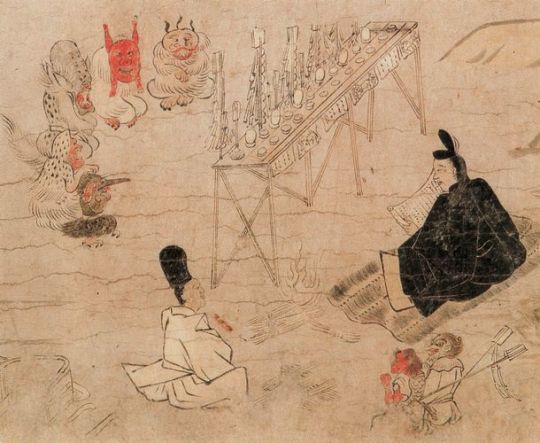
Abe no Seimei exorcising disease spirits (疫病神, yakubyōgami), as depicted in the Fudō Riyaku Engi Emaki. Two creatures who might be shikigami are visible in the bottom right corner (wikimedia commons; identification following Bernard Faure’s Rage and Ravage, pp. 57-58)
In popular culture, shikigami are basically synonymous with onmyōdō. Was this always the case, though? And what is a shikigami, anyway? These questions are surprisingly difficult to answer. I’ve been meaning to attempt to do so for a longer while, but other projects kept getting in the way. Under the cut, you will finally be able to learn all about this matter.
This isn’t just a shikigami article, though. Since historical context is a must, I also provide a brief history of onmyōdō and some of its luminaries. You will also learn if there were female onmyōji, when stars and time periods turn into deities, what onmyōdō has to do with a tale in which Zhong Kui became a king of a certain city in India - and more!
The early days of onmyōdō
In order to at least attempt to explain what the term shikigami might have originally entailed, I first need to briefly summarize the history of onmyōdō (陰陽道). This term can be translated as “way of yin and yang”, and at the core it was a Japanese adaptation of the concepts of, well, yin and yang, as well as the five elements. They reached Japan through Daoist and Buddhist sources. Daoism itself never really became a distinct religion in Japan, but onmyōdō is arguably among the most widespread adaptations of its principles in Japanese context.

Kibi no Makibi, as depicted by Yoshitoshi Tsukioka (wikimedia commons)
It’s not possible to speak of a singular founder of onmyōdō comparable to the patriarchs of Buddhist schools. Bernard Faure notes that in legends the role is sometimes assigned to Kibi no Makibi, an eighth century official who spent around 20 years in China. While he did bring many astronomical treatises with him when he returned, this is ultimately just a legend which developed long after he passed away.
In reality onmyōdō developed gradually starting with the sixth century, when Chinese methods of divination and treatises dealing with these topics first reached Japan. Early on Buddhist monks from the Korean kingdom of Baekje were the main sources of this knowledge. We know for example that the Soga clan employed such a specialist, a certain Gwalleuk (観勒; alternatively known under the Japanese reading of his name, Kanroku).
Obviously, divination was viewed as a very serious affair, so the imperial court aimed to regulate the continental techniques in some way. This was accomplished by emperor Tenmu with the formation of the onmyōryō (陰陽寮), “bureau of yin and yang” as a part of the ritsuryō system of governance. Much like in China, the need to control divination was driven by the fears that otherwise it would be used to legitimize courtly intrigues against the emperor, rebellions and other disturbances.
Officials taught and employed by onmyōryō were referred to as onmyōji (陰陽師). This term can be literally translated as “yin-yang master”. In the Nara period, they were understood essentially as a class of public servants. Their position didn’t substantially differ from that of other specialists from the onmyōryō: calendar makers, officials responsible for proper measurement of time and astrologers. The topics they dealt with evidently weren’t well known among commoners, and they were simply typical members of the literate administrative elite of their times.
Onmyōdō in the Heian period: magic, charisma and nobility
The role of onmyōji changed in the Heian period. They retained the position of official bureaucratic diviners in employ of the court, but they also acquired new duties. The distinction between them and other onmyōryō officials became blurred. Additionally their activity extended to what was collectively referred to as jujutsu (呪術), something like “magic” though this does not fully reflect the nuances of this term. They presided over rainmaking rituals, purification ceremonies, so-called “earth quelling”, and establishing complex networks of temporal and directional taboos.

A Muromachi period depiction of Abe no Seimei (wikimedia commons)
The most famous historical onmyōji like Kamo no Yasunori and his student Abe no Seimei were active at a time when this version of onmyōdō was a fully formed - though obviously still evolving - set of practices and beliefs. In a way they represented a new approach, though - one in which personal charisma seemed to matter just as much, if not more, than official position. This change was recognized as a breakthrough by at least some of their contemporaries. For example, according to the diary of Minamoto no Tsuneyori, the Sakeiki (左經記), “in Japan, the foundations of onmyōdō were laid by Yasunori”.
The changes in part reflected the fact that onmyōji started to be privately contracted for various reasons by aristocrats, in addition to serving the state. Shin’ichi Shigeta notes that it essentially turned them from civil servants into tradespeople. However, he stresses they cannot be considered clergymen: their position was more comparable to that of physicians, and there is no indication they viewed their activities as a distinct religion. Indeed, we know of multiple Heian onmyōji, like Koremune no Fumitaka or Kamo no Ieyoshi, who by their own admission were devout Buddhists who just happened to work as professional diviners.
Shin’ichi Shigeta notes is evidence that in addition to the official, state-sanctioned onmyōji, “unlicensed” onmyōji who acted and dressed like Buddhist clergy, hōshi onmyōji (法師陰陽師) existed. The best known example is Ashiya Dōman, a mainstay of Seimei legends, but others are mentioned in diaries, including the famous Pillow Book. It seems nobles particularly commonly employed them to curse rivals. This was a sphere official onmyōji abstained from due to legal regulations. Curses were effectively considered crimes, and government officials only performed apotropaic rituals meant to protect from them.
The Heian period version of onmyōdō captivated the imagination of writers and artists, and its slightly exaggerated version present in classic literature like Konjaku Monogatari is essentially what modern portrayals in fiction tend to go back to.
Medieval onmyōdō: from abstract concepts to deities

Gozu Tennō (wikimedia commons)
Further important developments occurred between the twelfth and fourteenth centuries. This period was the beginning of the Japanese “middle ages” which lasted all the way up to the establishment of the Tokugawa shogunate. The focus in onmyōdō in part shifted towards new, or at least reinvented, deities, such as calendarical spirits like Daishōgun (大将軍) and Ten’ichijin (天一神), personifications of astral bodies and concepts already crucial in earlier ceremonies. There was also an increased interest in Chinese cosmological figures like Pangu, reimagined in Japan as “king Banko”. However, the most famous example is arguably Gozu Tennō, who you might remember from my Susanoo article.
The changes in medieval onmyōdō can be described as a process of convergence with esoteric Buddhism. The points of connection were rituals focused on astral and underworld deities, such as Taizan Fukun or Shimei (Chinese Siming). Parallels can be drawn between this phenomenon and the intersection between esoteric Buddhism and some Daoist schools in Tang China. Early signs of the development of a direct connection between onmyōdō and Buddhism can already be found in sources from the Heian period, for example Kamo no Yasunori remarked that he and other onmyōji depend on the same sources to gain proper understanding of ceremonies focused on the Big Dipper as Shingon monks do.
Much of the information pertaining to the medieval form of onmyōdō is preserved in Hoki Naiden (ほき内伝; “Inner Tradition of the Square and the Round Offering Vessels”), a text which is part divination manual and part a collection of myths. According to tradition it was compiled by Abe no Seimei, though researchers generally date it to the fourteenth century. For what it’s worth, it does seem likely its author was a descendant of Seimei, though.
Outside of specialized scholarship Hoki Naiden is fairly obscure today, but it’s worth noting that it was a major part of the popular perception of onmyōdō in the Edo period. A novel whose influence is still visible in the modern image of Seimei, Abe no Seimei Monogatari (安部晴明物語), essentially revolves around it, for instance.
Onmyōdō in the Edo period: occupational licensing
Novels aside, the first post-medieval major turning point for the history of onmyōdō was the recognition of the Tsuchimikado family as its official overseers in 1683. They were by no means new to the scene - onmyōji from this family already served the Ashikaga shoguns over 250 years earlier. On top of that, they were descendants of the earlier Abe family, the onmyōji par excellence. The change was not quite the Tsuchimikado’s rise, but rather the fact the government entrusted them with essentially regulating occupational licensing for all onmyōji, even those who in earlier periods existed outside of official administration.
As a result of the new policies, various freelance practitioners could, at least in theory, obtain a permit to perform the duties of an onmyōji. However, as the influence of the Tsuchimikado expanded, they also sought to oblige various specialists who would not be considered onmyōji otherwise to purchase licenses from them. Their aim was to essentially bring all forms of divination under their control. This extended to clergy like Buddhist monks, shugenja and shrine priests on one hand, and to various performers like members of kagura troupes on the other.
Makoto Hayashi points out that while throughout history onmyōji has conventionally been considered a male occupation, it was possible for women to obtain licenses from the Tsuchimikado. Furthermore, there was no distinct term for female onmyōji, in contrast with how female counterparts of Buddhist monks, shrine priests and shugenja were referred to with different terms and had distinct roles defined by their gender.
As far as I know there’s no earlier evidence for female onmyōji, though, so it’s safe to say their emergence had a lot to do with the specifics of the new system. It seems the poems of the daughter of Kamo no Yasunori (her own name is unknown) indicate she was familiar with yin-yang theory or at least more broadly with Chinese philosophy, but that’s a topic for a separate article (stay tuned), and it's not quite the same, obviously.
The Tsuchimikado didn’t aim to create a specific ideology or systems of beliefs. Therefore, individual onmyōji - or, to be more accurate, individual people with onmyōji licenses - in theory could pursue new ideas. This in some cases lead to controversies: for instance, some of the people involved in the (in)famous 1827 Osaka trial of alleged Christians (whether this label really is applicable is a matter of heated debate) were officially licensed onmyōji. Some of them did indeed possess translated books written by Portuguese missionaries, which obviously reflected Catholic outlook. However, Bernard Faure suggests that some of the Edo period onmyōji might have pursued Portuguese sources not strictly because of an interest in Catholicism but simply to obtain another source of astronomical knowledge.
The legacy of onmyōdō
In the Meiji period, onmyōdō was banned alongside shugendō. While the latter tradition experienced a revival in the second half of the twentieth century, the former for the most part didn’t. However, that doesn’t mean the history of onmyōdō ends once and for all in the second half of the nineteenth century.
Even today in some parts of Japan there are local religious traditions which, while not identical with historical onmyōdō, retain a considerable degree of influence from it. An example often cited in scholarship is Izanagi-ryū (いざなぎ流) from the rural Monobe area in the Kōchi Prefecture. Mitsuki Ueno stresses that the occasional references to Izanagi-ryū as “modern onmyōdō” in literature from the 1990s and early 2000s are inaccurate, though. He points out they downplay the unique character of this tradition, and that it shows a variety of influences. Similar arguments have also been made regarding local traditions from the Chūgoku region.
Until relatively recently, in scholarship onmyōdō was basically ignored as superstition unworthy of serious inquiries. This changed in the final decades of the twentieth century, with growing focus on the Japanese middle ages among researchers. The first monographs on onmyōdō were published in the 1980s. While it’s not equally popular as a subject of research as esoteric Buddhism and shugendō, formerly neglected for similar reasons, it has nonetheless managed to become a mainstay of inquiries pertaining to the history of religion in Japan.
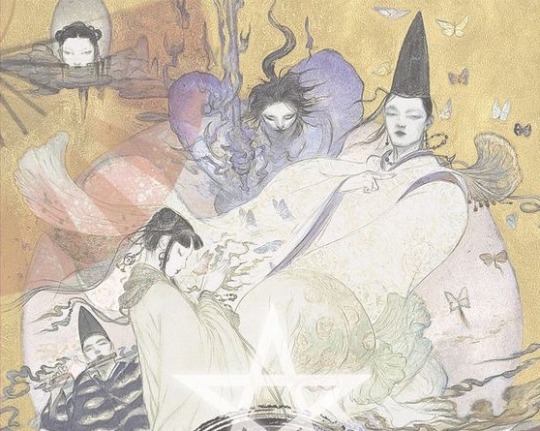
Yoshitaka Amano's illustration of Baku Yumemakura's fictionalized portrayal of Abe no Seimei (right) and other characters from his novels (reproduced here for educational purposes only)
Of course, it’s also impossible to talk about onmyōdō without mentioning the modern “onmyōdō boom”. Starting with the 1980s, onmyōdō once again became a relatively popular topic among writers. Novel series such as Baku Yumemakura’s Onmyōji, Hiroshi Aramata’s Teito Monogatari or Natsuhiko Kyōgoku’s Kyōgōkudō and their adaptations in other media once again popularized it among general audiences. Of course, since these are fantasy or mystery novels, their historical accuracy tends to vary (Yumemakura in particular is reasonably faithful to historical literature, though). Still, they have a lasting impact which would be impossible to accomplish with scholarship alone.
Shikigami: historical truth, historical fiction, or both?
You might have noticed that despite promising a history of shikigami, I haven’t used this term even once through the entire crash course in history of onmyōdō. This was a conscious choice. Shikigami do not appear in any onmyōdō texts, even though they are a mainstay of texts about onmyōdō, and especially of modern literature involving onmyōji.
It would be unfair to say shikigami and their prominence are merely a modern misconception, though. Virtually all of the famous legends about onmyōji feature shikigami, starting with the earliest examples from the eleventh century. Based on Konjaku Monogatari, there evidently was a fascination with shikigami at the time of its compilation. Fujiwara no Akihira in the Shinsarugakuki treats the control of shikigami as an essential skill of an onmyōji, alongside the abilities to “freely summon the twelve guardian deities, call thirty-six types of wild birds (...), create spells and talismans, open and close the eyes of kijin (鬼神; “demon gods”), and manipulate human souls”.
It is generally agreed that such accounts, even though they belong to the realm of literary fiction, can shed light on the nature and importance of shikigami. They ultimately reflect their historical context to some degree. Furthermore, it is not impossible that popular understanding of shikigami based on literary texts influenced genuine onmyōdō tradition. It’s worth pointing out that today legends about Abe no Seimei involving them are disseminated by two contemporary shrines dedicated to him, the Seimei Shrine (晴明神社) in Kyoto and the Abe no Seimei Shrine (安倍晴明神社) in Osaka. Interconnected networks of exchange between literature and religious practice are hardly a unique or modern phenomenon.
However, even with possible evidence from historical literature taken into account, it is not easy to define shikigami. The word itself can be written in three different ways: 式神 (or just 式), 識神 and 職神, with the first being the default option. The descriptions are even more varied, which understandably lead to the rise of numerous interpretations in modern scholarship. Carolyn Pang in her recent treatments of shikigami, which you can find in the bibliography, has recently divided them into five categories. I will follow her classification below.
Shikigami take 1: rikujin-shikisen
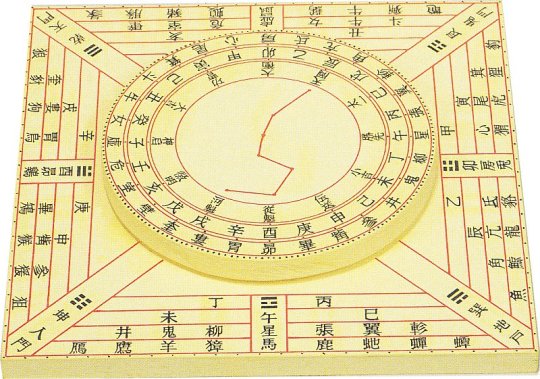
An example of shikiban, the divination board used in rikujin-shikisen (Museum of Kyoto, via onmarkproductions.com; reproduced here for educational purposes only)
A common view is that shikigami originate as a symbolic representation of the power of shikisen (式占) or more specifically rikujin-shikisen (六壬式占), the most common form of divination in onmyōdō. It developed from Chinese divination methods in the Nara period, and remained in the vogue all the way up to the sixteenth century, when it was replaced by ekisen (易占), a method derived from the Chinese Book of Changes.
Shikisen required a special divination board known as shikiban (式盤), which consists of a square base, the “earth panel” (地盤, jiban), and a rotating circle placed on top of it, the “heaven panel” (天盤, tenban). The former was marked with twelve points representing the signs of the zodiac and the latter with representations of the “twelve guardians of the months” (十二月将, jūni-gatsushō; their identity is not well defined). The heaven panel had to be rotated, and the diviner had to interpret what the resulting combination of symbols represents. Most commonly, it was treated as an indication whether an unusual phenomenon (怪/恠, ke) had positive or negative implications.
It’s worth pointing out that in the middle ages the shikiban also came to be used in some esoteric Buddhist rituals, chiefly these focused on Dakiniten, Shōten and Nyoirin Kannon. However, they were only performed between the late Heian and Muromachi periods, and relatively little is known about them. In most cases the divination board was most likely modified to reference the appropriate esoteric deities.
Shikigami take 2: cognitive abilities
While the view that shikigami represented shikisen is strengthened by the fact both terms share the kanji 式, a variant writing, 識神, lead to the development of another proposal. Since the basic meaning of 識 is “consciousness”, it is sometimes argued that shikigami were originally an “anthropomorphic realization of the active psychological or mental state”, as Caroline Pang put it - essentially, a representation of the will of an onmyōji. Most of the potential evidence in this case comes from Buddhist texts, such as Bosatsushotaikyō (菩薩処胎経).
However, Bernard Faure assumes that the writing 識神 was a secondary reinterpretation, basically a wordplay based on homonymy. He points out the Buddhist sources treat this writing of shikigami as a synonym of kushōjin (倶生神). This term can be literally translated as “deities born at the same time”. Most commonly it designates a pair of minor deities who, as their name indicates, come into existence when a person is born, and then records their deeds through their entire life. Once the time for Enma’s judgment after death comes, they present him with their compiled records. It has been argued that they essentially function like a personification of conscience.
Shikigami take 3: energy
A further speculative interpretation of shikigami in scholarship is that this term was understood as a type of energy present in objects or living beings which onmyōji were believed to be capable of drawing out and harnessing to their ends. This could be an adaptation of the Daoist notion of qi (氣). If this definition is correct, pieces of paper or wooden instruments used in purification ceremonies might be examples of objects utilized to channel shikigami.
The interpretation of shikigami as a form of energy is possibly reflected in Konjaku Monogatari in the tale The Tutelage of Abe no Seimei under Tadayuki. It revolves around Abe no Seimei’s visit to the house of the Buddhist monk Kuwanten from Hirosawa. Another of his guests asks Seimei if he is capable of killing a person with his powers, and if he possesses shikigami. He affirms that this is possible, but makes it clear that it is not an easy task. Since the guests keep urging him to demonstrate nonetheless, he promptly demonstrates it using a blade of grass. Once it falls on a frog, the animal is instantly crushed to death. From the same tale we learn that Seimei’s control over shikigami also let him remotely close the doors and shutters in his house while nobody was inside.
Shikigami take 4: curse
As I already mentioned, arts which can be broadly described as magic - like the already mentioned jujutsu or juhō (呪法, “magic rituals”) - were regarded as a core part of onmyōji’s repertoire from the Heian period onward. On top of that, the unlicensed onmyōji were almost exclusively associated with curses. Therefore, it probably won’t surprise you to learn that yet another theory suggests shikigami is simply a term for spells, curses or both. A possible example can be found in Konjaku Monogatari, in the tale Seimei sealing the young Archivist Minor Captains curse - the eponymous curse, which Seimei overcomes with protective rituals, is described as a shikigami.

Kunisuda Utagawa's illustration of an actor portraying Dōman in a kabuki play (wikimedia commons)
Similarities between certain descriptions of shikigami and practices such as fuko (巫蠱) and goraihō (五雷法) have been pointed out. Both of these originate in China. Fuko is the use of poisonous, venomous or otherwise negatively perceived animals to create curses, typically by putting them in jars, while goraihō is the Japanese version of Daoist spells meant to control supernatural beings, typically ghosts or foxes. It’s worth noting that a legend according to which Dōman cursed Fujiwara no Michinaga on behalf of lord Horikawa (Fujiwara no Akimitsu) involves him placing the curse - which is itself not described in detail - inside a jar.
Mitsuki Ueno notes that in the Kōchi Prefecture the phrase shiki wo utsu, “to strike with a shiki”, is still used to refer to cursing someone. However, shiki does not necessarily refer to shikigami in this context, but rather to a related but distinct concept - more on that later.
Shikigami take 5: supernatural being
While all four definitions I went through have their proponents, yet another option is by far the most common - the notion of shikigami being supernatural beings controlled by an onmyōji. This is essentially the standard understanding of the term today among general audiences. Sometimes attempts are made to identify it with a specific category of supernatural beings, like spirits (精霊, seirei), kijin or lesser deities (下級神, kakyū shin). However, none of these gained universal support. Generally speaking, there is no strong indication that shikigami were necessarily imagined as individualized beings with distinct traits.
The notion of shikigami being supernatural beings is not just a modern interpretation, though, for the sake of clarity. An early example where the term is unambiguously used this way is a tale from Ōkagami in which Seimei sends a nondescript shikigami to gather information. The entity, who is not described in detail, possesses supernatural skills, but simultaneously still needs to open doors and physically travel.
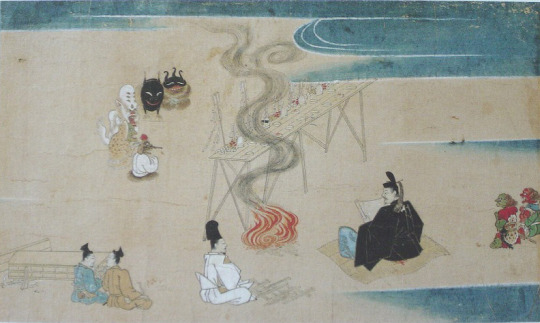
An illustration from Nakifudō Engi Emaki (wikimedia commons)
In Genpei Jōsuiki there is a reference to Seimei’s shikigami having a terrifying appearance which unnerved his wife so much he had to order the entities to hide under a bride instead of residing in his house. Carolyn Pang suggests that this reflects the demon-like depictions from works such as Abe no Seimei-kō Gazō (安倍晴明公画像; you can see it in the Heian section), Fudōriyaku Engi Emaki and Nakifudō Engi Emaki.
Shikigami and related concepts
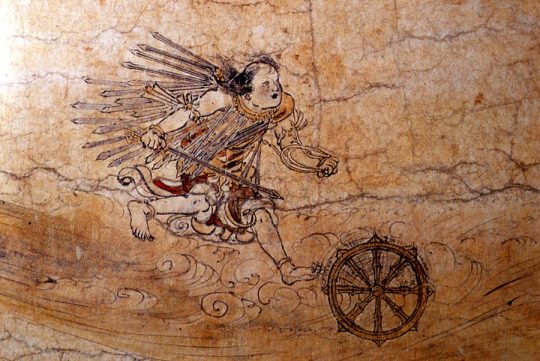
A gohō dōji, as depicted in the Shigisan Engi Emaki (wikimedia commons)
The understanding of shikigami as a “spirit servant” of sorts can be compared with the Buddhist concept of minor protective deities, gohō dōji (護法童子; literally “dharma-protecting lads”). These in turn were just one example of the broad category of gohō (護法), which could be applied to virtually any deity with protective qualities, like the historical Buddha’s defender Vajrapāṇi or the Four Heavenly Kings.
A notable difference between shikigami and gohō is the fact that the former generally required active summoning - through chanting spells and using mudras - while the latter manifested on their own in order to protect the pious. Granted, there are exceptions. There is a well attested legend according to which Abe no Seimei’s shikigami continued to protect his residence on own accord even after he passed away. Shikigami acting on their own are also mentioned in Zoku Kojidan (続古事談). It attributes the political downfall of Minamoto no Takaakira (源高明; 914–98) to his encounter with two shikigami who were left behind after the onmyōji who originally summoned them forgot about them.
A degree of overlap between various classes of supernatural helpers is evident in texts which refer to specific Buddhist figures as shikigami. I already brought up the case of the kushōjin earlier. Another good example is the Tendai monk Kōshū’s (光宗; 1276–1350) description of Oto Gohō (乙護法). He is “a shikigami that follows us like the shadow follows the body. Day or night, he never withdraws; he is the shikigami that protects us” (translation by Bernard Faure). This description is essentially a reversal of the relatively common title “demon who constantly follow beings” (常随魔, jōzuima). It was applied to figures such as Kōjin, Shōten or Matarajin, who were constantly waiting for a chance to obstruct rebirth in a pure land if not placated properly.

The Twelve Heavenly Generals (Tokyo National Museum, via wikimedia commons)
A well attested group of gohō, the Twelve Heavenly Generals (十二神将, jūni shinshō), and especially their leader Konpira (who you might remember from my previous article), could be labeled as shikigami. However, Fujiwara no Akihira’s description of onmyōji skills evidently presents them as two distinct classes of beings.

A kuda-gitsune, as depicted in Shōzan Chomon Kishū by Miyoshi Shōzan (Waseda University History Museum; reproduced here for educational purposes only)
Granted, Akihira also makes it clear that controlling shikigami and animals are two separate skills. Meanwhile, there is evidence that in some cases animal familiars, especially kuda-gitsune used by iizuna (a term referring to shugenja associated with the cult of, nomen omen, Iizuna Gongen, though more broadly also something along the lines of “sorcerer”), were perceived as shikigami.
Beliefs pertaining to gohō dōji and shikigami seemingly merged in Izanagi-ryū, which lead to the rise of the notion of shikiōji (式王子; ōji, literally “prince”, can be another term for gohō dōji). This term refers to supernatural beings summoned by a ritual specialist (祈祷師, kitōshi) using a special formula from doctrinal texts (法文, hōmon). They can fulfill various functions, though most commonly they are invoked to protect a person, to remove supernatural sources of diseases, to counter the influence of another shikiōji or in relation to curses.
Tenkeisei, the god of shikigami
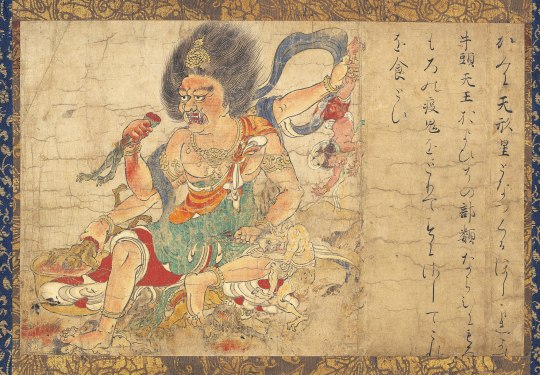
Tenkeisei (wikimedia commons)
The final matter which warrants some discussion is the unusual tradition regarding the origin of shikigami which revolves around a deity associated with this concept.
In the middle ages, a belief that there were exactly eighty four thousand shikigami developed. Their source was the god Tenkeisei (天刑星; also known as Tengyōshō). His name is the Japanese reading of Chinese Tianxingxing. It can be translated as “star of heavenly punishment”. This name fairly accurately explains his character. He was regarded as one of the so-called “baleful stars” (凶星, xiong xing) capable of controlling destiny. The “punishment” his name refers to is his treatment of disease demons (疫鬼, ekiki). However, he could punish humans too if not worshiped properly.
Today Tenkeisei is best known as one of the deities depicted in a series of paintings known as Extermination of Evil, dated to the end of the twelfth century. He has the appearance of a fairly standard multi-armed Buddhist deity. The anonymous painter added a darkly humorous touch by depicting him right as he dips one of the defeated demons in vinegar before eating him. Curiously, his adversaries are said to be Gozu Tennō and his retinue in the accompanying text. This, as you will quickly learn, is a rather unusual portrayal of the relationship between these two deities.
I’m actually not aware of any other depictions of Tenkeisei than the painting you can see above. Katja Triplett notes that onmyōdō rituals associated with him were likely surrounded by an aura of secrecy, and as a result most depictions of him were likely lost or destroyed. At the same time, it seems Tenkeisei enjoyed considerable popularity through the Kamakura period. This is not actually paradoxical when you take the historical context into account: as I outlined in my recent Amaterasu article, certain categories of knowledge were labeled as secret not to make their dissemination forbidden, but to imbue them with more meaning and value.
Numerous talismans inscribed with Tenkeisei’s name are known. Furthermore, manuals of rituals focused on him have been discovered. The best known of them, Tenkeisei-hō (天刑星法; “Tenkeisei rituals”), focuses on an abisha (阿尾捨, from Sanskrit āveśa), a ritual involving possession by the invoked deity. According to a legend was transmitted by Kibi no Makibi and Kamo no Yasunori. The historicity of this claim is doubtful, though: the legend has Kamo no Yasunori visit China, which he never did. Most likely mentioning him and Makibi was just a way to provide the text with additional legitimacy.
Other examples of similar Tenkeisei manuals include Tenkeisei Gyōhō (天刑星行法; “Methods of Tenkeisei Practice”) and Tenkeisei Gyōhō Shidai (天刑星行法次第; “Methods of Procedure for the Tenkeisei Practice”). Copies of these texts have been preserved in the Shingon temple Kōzan-ji.
The Hoki Naiden also mentions Tenkeisei. It equates him with Gozu Tennō, and explains both of these names refer to the same deity, Shōki (商貴), respectively in heaven and on earth. While Shōki is an adaptation of the famous Zhong Kui, it needs to be pointed out that here he is described not as a Tang period physician but as an ancient king of Rajgir in India. Furthermore, he is a yaksha, not a human. This fairly unique reinterpretation is also known from the historical treatise Genkō Shakusho.
Post scriptum
The goal of this article was never to define shikigami. In the light of modern scholarship, it’s basically impossible to provide a single definition in the first place. My aim was different: to illustrate that context is vital when it comes to understanding obscure historical terms. Through history, shikigami evidently meant slightly different things to different people, as reflected in literature. However, this meaning was nonetheless consistently rooted in the evolving perception of onmyōdō - and its internal changes. In other words, it reflected a world which was fundamentally alive.
The popular image of Japanese culture and religion is often that of an artificial, unchanging landscape straight from the “age of the gods”, largely invented in the nineteenth century or later to further less than noble goals. The case of shikigami proves it doesn’t need to be, though. The malleable, ever-changing image of shikigami, which remained a subject of popular speculation for centuries before reemerging in a similar role in modern times, proves that the more complex reality isn’t necessarily any less interesting to new audiences.
Bibliography
Bernard Faure, A Religion in Search of a Founder?
Idem, Rage and Ravage (Gods of Medieval Japan vol. 3)
Makoto Hayashi, The Female Christian Yin-Yang Master
Jun’ichi Koike, Onmyōdō and Folkloric Culture: Three Perspectives for the Development of Research
Irene H. Lin, Child Guardian Spirits (Gohō Dōji) in the Medieval Japanese Imaginaire
Yoshifumi Nishioka, Aspects of Shikiban-Based Mikkyō Rituals
Herman Ooms, Yin-Yang's Changing Clientele, 600-800 (note there is n apparent mistake in one of the footnotes, I'm pretty sure the author wanted to write Mesopotamian astronomy originated 4000 years ago, not 4 millenia BCE as he did; the latter date makes little sense)
Carolyn Pang, Spirit Servant: Narratives of Shikigami and Onmyōdō Developments
Idem, Uncovering Shikigami. The Search for the Spirit Servant of Onmyōdō
Shin’ichi Shigeta, Onmyōdō and the Aristocratic Culture of Everyday Life in Heian Japan
Idem, A Portrait of Abe no Seimei
Katja Triplett, Putting a Face on the Pathogen and Its Nemesis. Images of Tenkeisei and Gozutennō, Epidemic-Related Demons and Gods in Medieval Japan
Mitsuki Umeno, The Origins of the Izanagi-ryū Ritual Techniques: On the Basis of the Izanagi saimon
Katsuaki Yamashita, The Characteristics of On'yōdō and Related Texts
145 notes
·
View notes
Text

People of the Mojave: Enlist! [made by Zachary Fittzgerald]
#fallout#fallout show#fallout tv series#fallout amazon#fallout new vegas#fallout 4#fallout 3#fallout prime#NCR#new california republic#mojave#Mojave Bureau of Public Affairs of the New California Republic#Mojave Bureau of Public Affairs#New California Republic
173 notes
·
View notes
Video
#FCPD#fairfax county police department#Fallen Officers Memorial Service#FCPD Fallen Heroes#USA#America#Police Photography#FCPD Public Affairs Bureau#FCPD Digital; Media Team#United States of America#Northern Virginia#Commonwealth of Virginia#Virginia#Peacemakers#National Police Week#Fairfax Virginia#Fairfax County Police#Cops#Law Enforcement#Public Servants#FCPD Flickr#Police#flickr
4 notes
·
View notes
Text
🔘 Wednesday - ISRAEL REALTIME - Connecting to Israel in Realtime
▪️HUMAN RIGHTS WATCH REPORT - HAMAS COMMITTED A SYSTEMATIC ASSAULT AGAINST CIVILIANS.. The report condemned what the rights organization said were various war crimes and crimes against humanity, including “deliberate and indiscriminate attacks against civilians,” the use of civilians as human shields, and cruel and inhumane treatment, finding Hamas complicit with Oct. 7 war crimes. https://www.hrw.org/news/2024/07/17/october-7-crimes-against-humanity-war-crimes-hamas-led-groups
.. HAMAS - NO WE DIDN’T.. “We reject the lies contained in the Human Rights Watch report, the blatant bias for Israel and the lack of professionalism and credibility, and demand they withdraw it and apologize for it.“
▪️HEZBOLLAH THREATENS.. “The first step will be the launch of about 10,000 thousand missiles to military targets as far as south Israel. The second stage the Air Force is disabled. The third stage is a ground invasion towards settlements near the fence, killing and taking hostages.”
▪️HEZBOLLAH LEADER SAYS.. “fighting is a custom and honor (for us) martyrdom (is) from god."
▪️SMUGGLING TUNNELS.. The IDF believes it will take many more months to complete the search for Hamas's cross-border smuggling tunnels along the Gaza-Egypt border. So far, around 25 tunnels have been located. Combat engineers are currently meticulously sweeping the entire Gaza-Egypt border area in Rafah, while expanding the Philadelphi border corridor by demolishing structures within about 800 meters of the border.
▪️SICK CRIME & RUMORS.. a mother killed her young son yesterday in some kind of mental break. Rumors immediately swirled that the mother was a survivor of the Oct. 7 massacre. Bituach Leumi: this is untrue.
▪️SOCIETAL CONFLICT.. Last night a bus of soldiers returning from Gaza was, weirdly, diverted through Meah Shearim, the most ultra of ultra-orthodox neighborhoods in Israel. On seeing a bus of soldiers, the locals began to harass and pelt the bus - perhaps assuming they are coming to haul them away to the army.
▪️PROTEST - ANTI-ATTORNEY GENERAL.. Activists of the "If You Want" movement came this morning to demonstrate in front of the home of the Legal Adviser to the Government, Gali Beharev-Mara, in protest of the normalization of violations of public order.
▪️WHY NOT MORE ULTRA-ORTHODOX CONSCRIPTIONS? Foreign Affairs and Defense Committee Knesset members ask why the IDF doesn’t issue conscription orders to all yeshivas students of age? The IDF replies: "The conscription bureau doesn't know how to take in more." (( The IDF for years avoiding creating programs for this segment of society. ))
▪️NO CYBERTRUCKS FOR ISRAEL? The Ministry of Transport forbids Tesla's Cybertruck, to be tested or driven on Israeli roads. The amazing reason - the vehicle is (lightly) bulletproof. In Israel, a special permit is required to import a bulletproof vehicle, and the Cybertruck did not receive such a permit.
⭕ OVER 80 ROCKETS FIRED BY HEZBOLLAH towards Mt. Meron and surrounding areas last night, another 15+ FIRED AT NAHARIYA area.
♦️COUNTER-TERROR OPS - JENIN.. Arab channels show apparent special forces operating in Jenin with firefights.
♦️COUNTER-TERROR OPS - KALKILYA.. Firefight.
♦️SIGNIFICANT TARGETED AIRSTRIKES in CENTRAL GAZA overnight.
19 notes
·
View notes
Text
It was a time of fear and chaos four years ago.
The death count was mounting as COVID-19 spread. Financial markets were panicked. Oil prices briefly went negative. The Federal Reserve slashed its benchmark interest rates to combat the sudden recession. And the U.S. government went on a historic borrowing spree—adding trillions to the national debt—to keep families and businesses afloat.
But as Donald Trump recalled that moment at a recent rally, the former president exuded pride.
“We had the greatest economy in history,” the Republican told his Wisconsin audience. “The 30-year mortgage rate was at a record low, the lowest ever recorded ... 2.65%, that’s what your mortgage rates were.”
The question of who can best steer the U.S. economy could be a deciding factor in who wins November’s presidential election. While an April Gallup poll found that Americans were most likely to say that immigration is the country's top problem, the economy in general and inflation were also high on the list.
Trump may have an edge over President Joe Biden on key economic concerns, according to an April poll by The Associated Press-NORC Center for Public Affairs. The survey found that Americans were more likely to say that as president, Trump helped the country with job creation and cost of living. Nearly six in 10 Americans said that Biden’s presidency hurt the country on the cost of living.
But the economic numbers expose a far more complicated reality during Trump's time in the White House. His tax cuts never delivered the promised growth. His budget deficits surged and then stayed relatively high under Biden. His tariffs and trade deals never brought back all of the lost factory jobs.
And there was the pandemic, an event that caused historic job losses for which Trump accepts no responsibility as well as low inflation—for which Trump takes full credit.
If anything, the economy during Trump's presidency never lived up to his own hype.
DECENT (NOT EXCEPTIONAL) GROWTH
Trump assured the public in 2017 that the U.S. economy with his tax cuts would grow at “3%,” but he added, “I think it could go to 4, 5, and maybe even 6%, ultimately.”
If the 2020 pandemic is excluded, growth after inflation averaged 2.67% under Trump, according to figures from the Bureau of Economic Analysis. Include the pandemic-induced recession and that average drops to an anemic 1.45%.
By contrast, growth during the second term of then-President Barack Obama averaged 2.33%. So far under Biden, annual growth is averaging 3.4%.
MORE GOVERNMENT DEBT
Trump also assured the public that his tax cuts would pay for themselves because of stronger growth. The cuts were broad but disproportionately favored corporations and those with extreme wealth.
The tax cuts signed into law in 2017 never fulfilled Trump's promises on deficit reduction.
According to the Office of Management and Budget, the deficit worsened to $779 billion in 2018. The Congressional Budget Office had forecasted a deficit of $563 billion before the tax cuts, meaning the tax cuts increased borrowing by $216 billion that first year. In 2019, the deficit rose to $984 billion, nearly $300 billion more than what the CBO had forecast.
Then the pandemic happened and with a flurry of government aid, the resulting deficit topped $3.1 trillion. That borrowing enabled the government to make direct payments to individuals and small businesses as the economy was in lockdown, often increasing bank accounts and making many feel better off even though the economy was in a recession.
Deficits have also run high under Biden, as he signed into law a third round of pandemic aid and other initiatives to address climate change, build infrastructure and invest in U.S. manufacturing. His budget deficits: $2.8 trillion (2021), $1.38 trillion (2022), and $1.7 trillion (2023).
The CBO estimated in a report issued Wednesday that the extension of parts of Trump’s tax cuts set to expire after 2025 would add another $4.6 trillion to the national debt through the year 2034.
LOW INFLATION (BUT NOT ALWAYS FOR GOOD REASONS)
Inflation was much lower under Trump, never topping an annual rate of 2.4%, according to the Bureau of Labor Statistics. The annual rate reached as high as 8% in 2022 under Biden and is currently at 3.4%.
There were three big reasons why inflation was low during Trump's presidency: the legacy of the 2008 financial crisis, Federal Reserve actions, and the coronavirus pandemic.
Trump entered the White House with inflation already low, largely because of the slow recovery from the Great Recession, when financial markets collapsed and millions of people lost their homes to foreclosure.
The inflation rate barely averaged more than 1% during Obama's second term as the Fed struggled to push up growth. Still, the economy was expanding without overheating.
But in the first three years of Trump's presidency, inflation averaged 2.1%, roughly close to the Fed's target. Still, the Fed began to hike its own benchmark rate to keep inflation low at the central bank's own 2% target. Trump repeatedly criticized the Fed because he wanted to juice growth despite the risks of higher prices.
Then the pandemic hit.
Inflation sank and the Fed slashed rates to sustain the economy during lockdowns.
When Trump celebrates historically low mortgage rates, he's doing so because the economy was weakened by the pandemic. Similarly, gasoline prices fell below an average of $2 a gallon because no one was driving in April 2020 as the pandemic spread.
FEWER JOBS
The United States lost 2.7 million jobs during Trump's presidency, according to the Bureau of Labor Statistics. If the pandemic months are excluded, he added 6.7 million jobs.
By contrast, 15.4 million jobs were added during Biden's presidency. That's 5.1 million more jobs than what the CBO forecasted he would add before his coronavirus relief and other policies became law—a sign of how much he boosted the labor market.
Both candidates have repeatedly promised to bring back factory jobs. Between 2017 and the middle of 2019, Trump added 461,000 manufacturing jobs. But the gains began to stall and then turned into layoffs during the pandemic, with the Republican posting a loss of 178,000 jobs.
So far, the U.S. economy has added 773,000 manufacturing jobs during Biden's presidency.
Campaign Action
22 notes
·
View notes
Text
Democracy Manifest
Elected Government In The United Commonwealth
Well, thank you @theprissythumbelina for giving me the kick I needed to get started on this topic, I hope you enjoy what's to come! Otherwise, I'll Tag @athenswrites @caxycreations @hessdalen-globe @nerdexer @the-ellia-west @avrablake @coffeewritesfiction @vyuntspakhkite-l-darling
A/N: This took... so long...
But I can't say I'm not happy with it!
The House
The Parliament of the United Commonwealth is the highest legislative body of the UC, comprised of 5,227 elected Members representing the over four billion citizens of that polity. From its seat in Parliament House on the Weslich island of Sudpulau, this body, the single largest legislature in the 12 Worlds, passes the laws of the Commonwealth.
The Vote
Elections to Parliament are held every four years, with the exception of by-elections which occur to satisfy vacancies. They occur on a one-person-one-vote, secret-ballot basis using a 'Single Transferable Vote', and are open to all adult (>18) citizens who have been citizens for at least two months. Elections are overseen by the Electoral Activities Bureau, an independent public body, which manages the continents spanning infrastructure required for elections and draws the term's electoral map prior to every election.
The Member
Seats are open to any adult citizen who wishes to run regardless of any demographic, with the only restriction being if one is currently under a criminal trial or is incarcerated. Members are not bound by any term limits, and the only barrier to their Seat is the vote of their constituency.
The Three
Three individual Members dominate the House.
Firstly is the Chief Minister, Head of State and Government of the United Commonwealth and voted in by a simple majority of members.
Next is the Leader of the Opposition, bestowed with a simple majority of non-Government Members. Their lot is to hold the Government to account at every turn, patiently awaiting their turn on the opposite Bench.
Finally, is the Speaker of the House, approved with a simple majority and presiding over the business and conduct of Parliament in its frequently lively discourse.
No term limits apply on any of these offices, and all can be revoked with a vote of no confidence from the whole House, or the Opposition alone in the LoO's case.
The Benches
The vast majority of Members are, however, not seated in a formally recognised office; Unlike many national Parliamentary systems, at present no further formal Cabinet exists beyond the CM, a state of affairs viewed with increasing skepticism.
Instead, backbenchers on either side are as a rule 'organised' on a highly ad hoc basis, shifting with Party and Coalition tastes and the wider circumstances of the Commonwealth.
First and foremost among these organisations are the Parties.
Parliament's Members are nearly all affiliated with any of numerous political parties, though parties themselves are not recognised organisations in the eyes of the government de jure. They may range in size from a thousand or more members spread across member states, to a dozen or so, and have been founded and internally organised along an infinite number of ideals.
Both the LoO and CM are almost always the 'leaders' of their respective party, though the way appointments to either office are decided on is at every party's discretion. Party leaders outside either office are nonetheless still key elements of the political ecosystem, guiding their members into and between Coalitions.
A universal feature of all major parties are Party Whips, Members appointed within their party's ranks and charged with ensuring that their colleagues cast their vote precisely as their Leader wishes. Though not imbued with any unique power within the House, beyond its chambers they can hold the life and death of any politician's career in their hands, and are commonly seen as the right hands of their respective leaders.
Aside from these two positions, the actual make up and structure of political parties is highly diverse, and often highly fluid, reliant as much on circumstances outside the House as in it. The criteria for membership, its exclusivity, and internal Party appointments differ greatly between Parties, which form, merge, die off, or reform themselves in an unending state of change. One could at any point found a Party of their own for any reason if it suited them, and the only restriction they'd need worry about is the will of their constituents.
However, no Party in history has ever achieved a unilateral majority in the House, and thus forming a government is an exercise in Coalition building and breaking above anything else. Coalitions, like the parties that make them, are not bound or recognised by any rule of Parliament, and so the rules and dynamics that define them change with every government and election. Chief Ministers as a rule come from the largest Party in the largest Coalition who can agree to vote for them, but ultimately no law dictates that a minority Leader could not hold that office.
Finally, comes Committees. As above, Committees themselves are not strictly recognised bodies, but are formed and governed on an as needs basis according to long established precedents and expectations. Typically, Government, Opposition, and House Committees exist simultaneously on any range of subjects, with the latter including Members from both groups. While Committees are never necessary for relevant legislation to pass, deference to their existence and decisions is a political inevitability.
Though Independent Members exist, they are a rare occurrence outside of the most 'recently democratic' member states. Where they do appear, however, they usually rely on a combination of their own extremely great charisma, some specifically and highly localised appeal, and Party apathy to gain and hold their Seats. Still, unseating such Members is often an uphill and unpopular struggle. Once in the House, Independents typically have a very difficult time intruding themselves into the business of Parliament, and where they do tend to make their case on issues distinctly relevant to their constituencies.
In summary, while the Charter of Parliament never established any further positions beyond the Speaker, Chief Minister, and Leader of the Opposition, the House has in the century since built for itself a long and deep institution of customs and traditions with which its internal business is regulated and managed. Such a 'laissez faire' approach to politics mirrors well the UC's generally fluid approach to government at large, and very much conforms with the original intentions of the earliest theorists and politicians who had established the Commonwealth long before. While at times these institutions have faltered in the face of politicial crises in the past, they have survived, and seem set to continue to survive.
The Legislative Process
While Parliament has an absolute and final say on the passing of Bills into Acts of Parliament and thus the law of the land, it is not the only body involved in the legislative process.
The first step in this process is the introduction of a Bill into Parliament. Any Member can introduce any Bill they wish at any time, but this right is also held by both the Commission of the UC, its independent executive body, and the Council of Ministers, comprised of member states governments' cabinet executives.
After this, Bills may legally be immediately passed into law if a majority of Members vote in agreement. Such an event is, however, exceedingly rare, and no Member of any affiliation is likely to cast their vote before a Bill undergoes an intensive debate.
The Bill in question is first submitted to the most relevant House Committee for initial investigation and debate. This might involve summoning and interrogating government or private individuals, alter and negotiate over the details of Bills, or even introducing their own Bills with a complete background onto the floor.
This begins an occasionally recursive loop of Bill debates, failed votes to pass, and returns to Committee for further alterations. Considering the sheer number of Bills on the floor at any given time, most such debate takes place in the numerous sub-chambers housed within Parliament House's vast structure, returning to the main chamber only for final votes.
Assuming a majority of Members vote in favour of it, the Bill passes into the Council of Ministers for a final check. Effectively acting as a 'semi-Upper House', the CoM only rarely invokes its right to dismiss a Bill for further debate with their own recommendations, a power which can only be used on any given Bill once. Typically, though, the Council will have made its intentions known well before this stage, and so Bills which are handed to it usually sail through without alteration.
Thus, as far as 'speed' is concerned, the time it takes for a Bill to pass ranges from days, to years, to, of course, never. The lack of a 2/3rds supermajority requirement for any action at all at least limits that angle, and the intensity of debate and diversity of potential views that exists leads to a long but undeniably thorough and expansive legislative process.
------
Further Details...
On Members
The equity of Parliament's ranks under the law is for the most part well established in reality. Sheer wealth at either a personal or party level is rarely corroborated with electoral success, especially given the UC's wide reaching and strict financial transparency laws. Nonetheless, a number of factors can serve to shape the electability of a candidate beyond how skill and ideological appeal.
More specifically, the tendency to favour candidates based on race, ethnicity, class, sexuality, or gender is more common in regions and their societies which are relatively new to the United Commonwealth and its own brand of social and cultural 'liberalism'. In societies where the UC's social and political culture have become more entrenched, such influences hold less influence than individual charisma, oratorical skill, and of course how they align with the political movements and issues of the day.
On Committees
The fluidity of Committes has at times been both a strength and a weakness, and is always bound by prior traditions more than anything else.
For all intents and purposes, the notion of any Committee's 'legitimacy' relies on the mutual consent of the House at large. The size, partisan diversity, and proportionality of a Committee are never set in stone, and in truth any specific Committee lives and dies within the term it was made in, becoming unrecognisable as changes in the make up of the wider House lead to renegotiations of its status.
In order to prevent the endless expansion of the number of Committees that this anarchic system often threatens to cause, many political Parties have reached agreements outside the House on a list of issues for which House Committees, are to be established on a long term basis. These include those on the Armed Forces, Security and Intelligence, and Foreign Affairs, among other significant issues of government. The size and authority of such 'Standing Committees' is thus largely guaranteed between governments, giving a much needed sense of order and continuity to the whole affair.
Every House Standing Committee is mirrored by Government and Opposition Committees on the same issue, and inter-party negotiations are dominated by the allocation of Committee seats to each represented Party. The latter two represent the interests of their respective halves of the House, and all three have their membership apportioned according to each Party's size.
In addition to these Standing Committees are an ever changing number of Provisional Committees, referring to those which lack the 'official' agreed recognition of the Parties 'in writing' but which nonetheless function with their consent and participation. These may come into and out of existence with time as issues surface or die out, and those of particular longevity may find themselves on the list to become Standing Committees in full. Provisional Committees might include Inquiry Committees, or Regional Committees aligned to areas suddenly facing crises.
Once the proportions of Committee membership have been parceled out, how Parties hand out their Members across roles is left to their discretion, unless the negotiation process prior had specified some limited requirements. Seniority, expertise, and a Member's constituency and its concerns are all regular considerations, amongst others, and of course the internal politics of that Party.
Aside from this, however, Parties and Members are free to associate with each other in whatever groups they wish to. It is, however, generally considered 'bad form', or political suicide, for anyone to declare that any already agreed upon Committee is irrelevant or not recognised, or to attempt to usurp their legitimacy by convincing others to join their cause. The agreements mentioned above universally condemn such activity, and any Party looking to engage in it is liable to find itself ostracised from the business of the House and evicted by their voters, who often are informed enough of political culture to express displeasure at spoiling 'their' vote.
------
And that's a wrap! Depending on if anyone has any further questions, my own actual motivation and time, and whether I get any further ideas, I might write a second part to this post. If I do, it'll either go into the history of how this system formed over time, or maybe a specific case study on some political ideologies, movements, and parties. Or I won't. Who knows.
15 notes
·
View notes